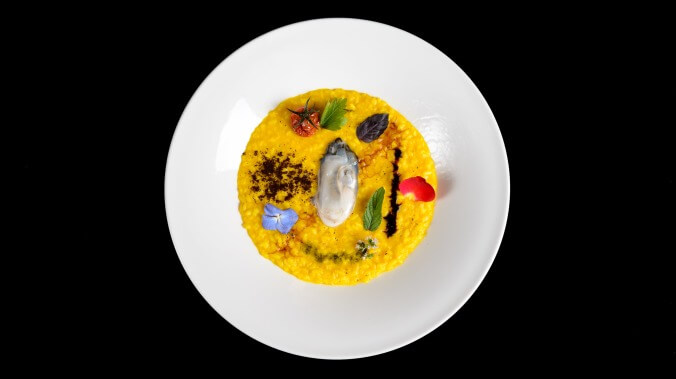He and the rest of the Futurists decided to lean into the backlash by trolling the public with increasingly unappealing dishes—mortadella with nougat, or pineapples with sardines.
Thing we were happiest to learn: Futurists were way ahead of the curve on molecular gastronomy. Obsessed as they were with modernity and machinery, the futurists were big on kitchen gadgets, including using chemical indicators to determine if food needed more seasoning, and colloidal mills to pulverize food. Some of their kitchen equipment was a bit more questionable, like ozonizers “to give the food the smell of ozone,” ultraviolet light that would purportedly “activate vitamins,” and electrolyzers “to decompose items into new forms and properties,” which sounds disconcertingly vague.
Thing we were unhappiest to learn: None of Futurist cooking’s elaborate rules seem to have been written with actually enjoying a meal in mind. While Futurist chefs strove for “absolute originality” in the food, sometimes the tried-and-true is pretty appealing, when the alternative is dishes like Diabolical Roses (deep-fried roses in full bloom), Milk In A Green Light (a bowl of milk, with black grapes and radishes, illuminated by a green light. For dessert, enjoy Italian Breasts In The Sunshine (almond paste topped with a strawberry and sprinkled with black pepper).
Futurist cooking also suggests sculpting meat, and “use of perfumes to enhance the tasting experience.” As anyone who’s ever kissed someone’s neck and gotten a mouthful of perfume as a reward can attest, that’s good eatin’.
Also noteworthy: Not content to impose their bizarre vision on individual recipes, Futurist chefs concocted entire insane dinner parties. The Futurist Cookbook describes the Tactile Dinner, in which each guest puts on a pair of pajamas, each covered in a different material (sponge, sandpaper, cork, felt). Guests are then taken into a darkened room, and choose a dinner partner according to their “tactile impression,” only seeing who they’ve paired up with upon entering the dining room. The first course is “polyrhythmic salad,” a bowl of lettuce, dates, and grapes with no dressing, to be eaten with one hand while diners crank a music box with the other, which the waiters dance to.
The second course is “magic food,” balls of caramel filled with surprise ingredients including raw meat, garlic, mashed banana, or chocolate, served in small bowls, “covered with tactile materials.” The third course is “tactile vegetable garden,” more raw vegetables, sans dressing, which must be eaten without using the hands. Instead, diners are expected to bury their face in the plate of vegetables, “feeling the sensation of the greens on their face.” Every time they raise their head, the waiters spray their face with perfume, because if there’s anything better than tasting perfume, it’s having it sprayed into your eyes.
Best link to elsewhere on Wikipedia: Besides the numerous aesthetic rules Marinetti established in Manifesto, he also insisted that Italians stop eating foreign food, and stop using foreign names for food, wanting to rename the sandwich the traidue (“between two”), and retitle “maitre d” to “guidopalato” (“palate guide”). Food critic Elizabeth David accused Marinetti’s nationalism, absurdist as it may have been, to be rooted in that other early 20th-century Italian movement, fascism. That far-right political movement, based on outspoken nationalism, suppressing dissent while claiming the mantle of populism, and a leader who “proposes only he can solve [the country’s problems] and all his political opponents are enemies or traitors,” is worth reading up on just out of pure intellectual curiosity and not because it’s become suddenly relevant or anything.
Further Down The Wormhole: One of the more striking breaks from tradition in Futurist cooking (which is only given passing mention here) is doing away with that ubiquitous utensil, the humble fork. While the fork is associated with Western cuisine and chopsticks with China, the fork in fact originated in China, while as late as the 10th century Italians were eating pasta with a “long wooden spike,” not unlike a chopstick.
Chinese forks have been found in Bronze Age archeological sites, and are depicted in art dating back to the Han Dynasty. Han was the second imperial dynasty, ruling from 202 BC to AD 220, and an interesting fact we’re jumping to solely for the sake of the next link is that wealthy Han-era citizens wore silk, and coats make from fox fur, while peasants’ clothes were made of wool, hemp, and ferret fur.
Ferrets are a domesticated version of the polecat, and have been kept as pets for roughly 2,500 years. They’re occasionally used for hunting rabbits, and on one bizarre occasion have been inducted into the world of sports. We’ll look at the ill-advised sport of ferret-legging—which involves shoving one of the animals down one’s pants—next week.









































